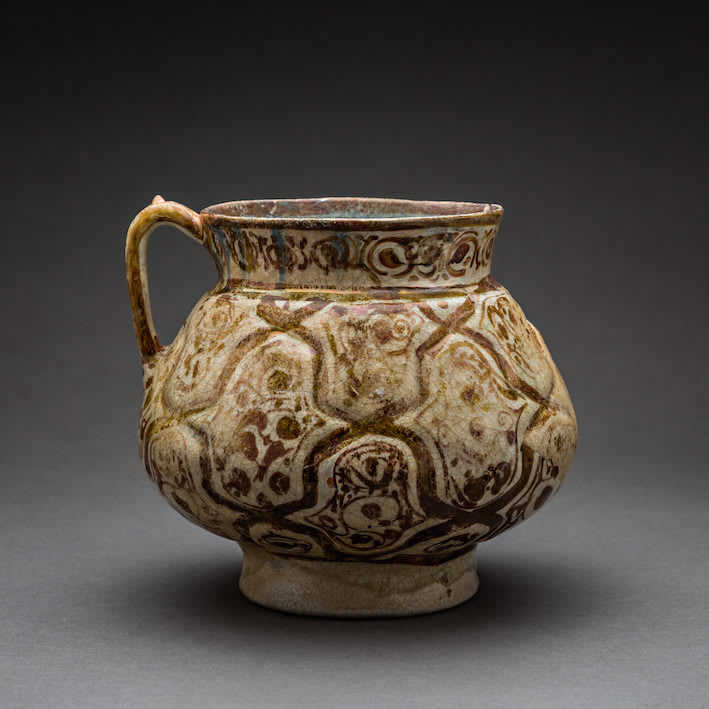Kashan lustre vessel, 1200 CE - 1300 CE
Fritware
15.7 x 11.9 cm
6 1/4 x 4 3/4 in
6 1/4 x 4 3/4 in
LK.002
The vessel has a bulbous body and a slight flaring neck, with one handle. It is profusely decorated with brown lustre with panels and friezes containing vegetal patterns. The top...
The vessel has a bulbous body and a slight flaring neck, with one handle. It is profusely decorated with brown lustre with panels and friezes containing vegetal patterns. The top rim is decorated in lustre on an opacified tin glaze with a broad band of chain pattern. Traces of cobalt blue are clearly visible on the jar. Adding cobalt blue to the lustre decoration was also a typical feature of Kashan ware.
The town of Kashan, currently located in the Isfahan province of Iran, has been historically associated with a high-quality ceramic production during the medieval period, becoming a major site for the manufacture of fine wares between the 1170s and 1220s as well as in the later 13th and early 14th centuries.
Lustre, having been first used on glazed pottery in 9th century Iraq, became very popular in the 10th-12th centuries in Fatimid Egypt, and then reached new heights in Seljuk Iran around the 13th century, before the Mongol invasions.
The centre of the Persian lustre industry was Kashan. The creation of lustre-painted ware is a costly process that requires considerable expertise. Compounds containing metal oxides, sulphur, and a refractory medium, such as ochre, are painted onto a previously glazed and fired surface. On the wares associated with Kashan the glaze was normally opacified with tin, although a (presumably cheaper) clear glaze was sometimes used for the internal surfaces of closed forms such as bottles and jugs.
During this period, Muslim potters developed a new and finer material than clay, “frit”, consisting of about ten parts of crushed quartz, one part white clay and one part glass frit made by melting crushed quarts and potash and crushing the substance again.
The town of Kashan, currently located in the Isfahan province of Iran, has been historically associated with a high-quality ceramic production during the medieval period, becoming a major site for the manufacture of fine wares between the 1170s and 1220s as well as in the later 13th and early 14th centuries.
Lustre, having been first used on glazed pottery in 9th century Iraq, became very popular in the 10th-12th centuries in Fatimid Egypt, and then reached new heights in Seljuk Iran around the 13th century, before the Mongol invasions.
The centre of the Persian lustre industry was Kashan. The creation of lustre-painted ware is a costly process that requires considerable expertise. Compounds containing metal oxides, sulphur, and a refractory medium, such as ochre, are painted onto a previously glazed and fired surface. On the wares associated with Kashan the glaze was normally opacified with tin, although a (presumably cheaper) clear glaze was sometimes used for the internal surfaces of closed forms such as bottles and jugs.
During this period, Muslim potters developed a new and finer material than clay, “frit”, consisting of about ten parts of crushed quartz, one part white clay and one part glass frit made by melting crushed quarts and potash and crushing the substance again.



